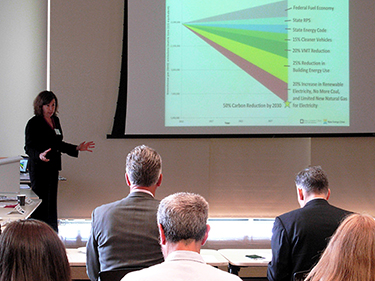|
Subscribe / Renew |
|
|
Contact Us |
|
| ► Subscribe to our Free Weekly Newsletter | |
| home | Welcome, sign in or click here to subscribe. | login |
Environment
| |
 |
September 24, 2015
Survey: Climate Solutions
Specialty: Clean energy economy nonprofit that finds practical and profitable solutions to global warming
Management: Gregg Small, executive director; Kristen Sheeran, Oregon director; Eileen V. Quigley, director of strategic innovation
Founded: 1998
Headquarters: Seattle
2014 revenues: $3.4 million
Projected 2015 revenues: $2.9 million
Projects: Founding member of Renew Oregon and the Alliance for Jobs and Clean Energy, two state-level networks of leaders dedicated to strengthening the economy by reducing global warming; involving businesses in climate and clean energy policy; researching ways to transition from a fossil fuel economy to a low-carbon, clean economy
Jonathan Lawson, digital communications manager for Climate Solutions, answered questions from the DJC about the nonprofit’s work.
Q: What do you do for businesses, and who pays for it?
A: Climate Solutions works with businesses to promote practical and profitable solutions to our climate and energy challenges, including energy efficiency, renewable energy and alternative fuels. We help inform businesses about clean energy and energy efficiency solutions most applicable to their own operations, and give them a voice in the development of smart policy that promotes clean and efficient energy.
We played a key role in convening the Washington Businesses for Climate Action, and are organizing Washington and Oregon businesses as a powerful constituency for backing strong action to combat global warming. Climate Solutions shines a spotlight on companies that are leading in developing climate solutions, and provides opportunities for networking and engagement with other executives.
Our work is funded through support from individual donors, business sponsorships, foundation grants and fee-for-service consulting work for governmental clients.
Q: How can developers and public agencies make buildings more efficient?
A: New buildings are capable of exceptional energy performance. Designing and constructing buildings to minimize energy demand — through high-performance walls, advanced air systems, daylighting, passive solar heating, water conservation, conversion of waste heat into energy and other measures — is just the beginning.
Regular building “tune-ups” are also critical to show what’s working and what’s not. In its public buildings, King County is partnering with MacDonald-Miller, Iconics and Microsoft on an energy-smart buildings project at five King County facilities that will show county building managers the real-time energy use of their facilities. Without adding new meters or sensors, the software the managers use will draw from existing data to show where buildings are wasting energy, why, and what to fix.
Q: How can cities become more sustainable?
A: Cities represent over 70 percent of global carbon emissions. Over the past decade and more, local governments have made enormous progress in charting their paths to a low-carbon future through building energy efficiency, renewable energy and clean transportation. Examples include financial support for deep building retrofits, rooftop solar installation campaigns, and expansion of electric vehicle charging networks.
Local officials have set bold climate and clean energy goals, exerted political power to achieve those agendas, and are working on durable, meaningful carbon reduction solutions. These reductions are not drops in the bucket: a New Climate Economy 2015 report found that local climate actions in buildings, transportation and waste management could save $16.6 trillion from now to 2050, concluding that investments would pay for themselves within 16 years. The same report found that with national support for city efforts, savings could reach $22 trillion, and the planet could avoid emissions on the scale of India’s current carbon footprint.
Q: What’s the most exciting innovation you’ve recently seen?
A: There are two types of innovations that are important to our work. Here are examples of both:
• From a technical standpoint, the Bullitt Center in Seattle is the greenest and most efficient commercial office building in the world, producing zero carbon emissions and slashing other wastes and toxics. Many cutting-edge innovations embodied in that project are already making their way into commercial projects.
• From a policy standpoint, California stands out. With the most comprehensive climate and clean energy policies in the country if not the world, California has also shown that economic growth and cutting carbon can go hand in hand, with job growth well above national benchmarks. Increasingly, business leaders in the state are uniting behind strong climate and clean energy policies, recognizing that the state can brand itself as a world leader in the transition to a low-carbon economy.
Q: Too much regulation or not enough?
A: The Northwest is burning, and the global climate is changing faster than anyone expected. It’s not just that we are not moving fast enough in the right direction. We are continuing to move in the wrong direction. That’s why we urgently need to regulate carbon emissions, to stop exacerbating the problem. It’s important good news that the market for clean energy solutions is accelerating; we need and will have new sources of energy that are clean, sustainable and profitable. We are seeing enormous strides in energy efficiency and renewable energy.
Just as we need to keep expanding innovation on those areas, the market we have will not solve the problem of runaway carbon emissions on its own.
Other Stories:
- LID development training is a game changer here
- Survey: Shannon & Wilson
- Survey: Ridolfi
- Survey: O’Brien & Co.
- Survey: Cascadia Consulting Group
- Survey: Golder Associates
- How deep green buildings can educate kids
- Here’s how to improve environmental health and safety
- New Ecology cleanup guidance: mirage or oasis?
- Kirkland taps county’s purple pipes for recycled water
- Drought heats up battle over water rights
- Designing infrastructure to combat climate change
- Building green? Don’t forget green financing
- Survey: Innovex Environmental Management



